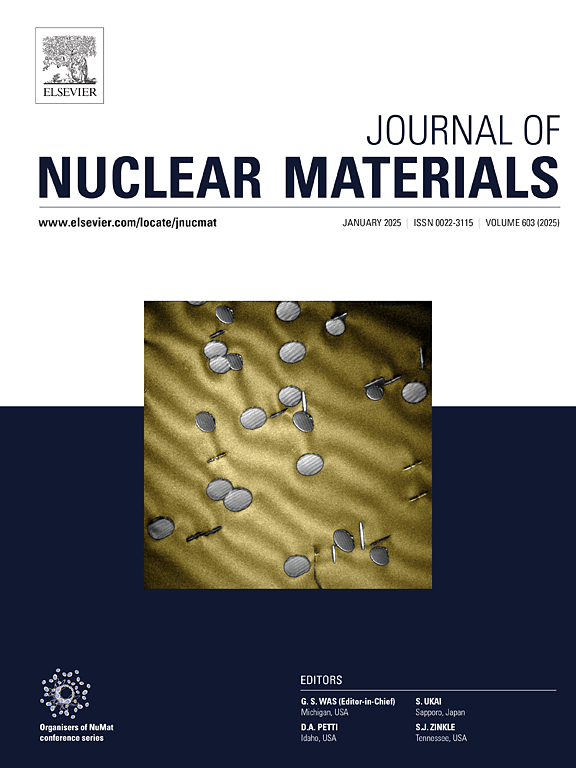Microstructure, thermal properties and irradiation behaviors of uranium nitride (UN) nuclear fuel densified by Spark Plasma Sintering (SPS)
IF 2.8
2区 工程技术
Q3 MATERIALS SCIENCE, MULTIDISCIPLINARY
引用次数: 0
Abstract
This study investigated the microstructure, thermal properties, and irradiation behavior of uranium nitride (UN) fuel pellets synthesized via Spark Plasma Sintering (SPS). The highly densified UN pellets were successfully achieved by SPS at 1600 °C with a theoretical density above 96 % TD. The SPS-densified UN pellets exhibited good resistance to irradiation swelling, and the lattice constants, phase fractions, and surface roughness of the irradiated region demonstrated high stability. TEM results showed that dislocation loops and Ar bubbles were observed in the irradiated samples, with number densities of 4.74 × 1023 and 1.06 × 1024 /m3, respectively. Furthermore, the data analyzed by the Frequency Domain Thermal Reflection (FDTR) technique matched the data from Laser Flash Analyzer (LFA), confirming the suitability of FDTR for measuring the thermal conductivity of irradiated layers, which was found to be 20 % less than unirradiated values. It was inferred that the dislocation loops and Ar bubbles were the crucial reasons for the decreased thermal conductivity. The results provided valuable insights into the thermal properties and irradiation behaviors of SPS-sintered UN pellets.
求助全文
约1分钟内获得全文
求助全文
来源期刊

Journal of Nuclear Materials
工程技术-材料科学:综合
CiteScore
5.70
自引率
25.80%
发文量
601
审稿时长
63 days
期刊介绍:
The Journal of Nuclear Materials publishes high quality papers in materials research for nuclear applications, primarily fission reactors, fusion reactors, and similar environments including radiation areas of charged particle accelerators. Both original research and critical review papers covering experimental, theoretical, and computational aspects of either fundamental or applied nature are welcome.
The breadth of the field is such that a wide range of processes and properties in the field of materials science and engineering is of interest to the readership, spanning atom-scale processes, microstructures, thermodynamics, mechanical properties, physical properties, and corrosion, for example.
Topics covered by JNM
Fission reactor materials, including fuels, cladding, core structures, pressure vessels, coolant interactions with materials, moderator and control components, fission product behavior.
Materials aspects of the entire fuel cycle.
Materials aspects of the actinides and their compounds.
Performance of nuclear waste materials; materials aspects of the immobilization of wastes.
Fusion reactor materials, including first walls, blankets, insulators and magnets.
Neutron and charged particle radiation effects in materials, including defects, transmutations, microstructures, phase changes and macroscopic properties.
Interaction of plasmas, ion beams, electron beams and electromagnetic radiation with materials relevant to nuclear systems.
 求助内容:
求助内容: 应助结果提醒方式:
应助结果提醒方式:


